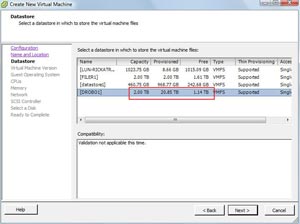The Other Side of Thin Provisioning: Managing Oversubscription
In my post, "
Religious Issue #6: Thin Provisioning," a number of people piped up with comments, as I expected. I'm a fan of thin provisioning and use it in almost every situation for my virtualization practice. But, there is one side of thin provisioning that is more of an art than a science: managing oversubscription.
The basic premise of oversubscription is that by the space savings of thin provisioning, the provisioned amount can exceed the threshold of raw capacity. In my personal lab, I have oversubscribed the primary VMFS datastore by over 18 TB (see Fig. 1). This isn't what I would do in the real world, but nonetheless it is tracked by vSphere.
Oversubscription is not necessarily a bad thing; in fact, SAN admins have been doing this for some time. For the typical Windows administrator who has graduated to virtualization administrator, managing oversubscription may be a new skill.
I'd like to point out one caveat to thin provisioning: performance. Thin provisioning by itself has minimal impact on a virtual machine's performance. In Tuesday's post, Scott Drummonds posts a few of his thoughts and a link to VMware thin provisioning white paper. (Thanks, Scott!) In that resource, Figure 4 shows that thin provision has effectively no impact on performance.
 |
|
Figure 1. The VMFS volume has allocated virtual machines much more storage than is available. (Click image to view larger version.) |
My observation on thin provisioning is that the same datastore may have been heavily consumed by free space of a virtual machine, is now populated with the real usage of a virtual machine. We are now able to achieve a greater datastore density, and based on the workloads on that type of disk, we may observe performance differences simply by consolidating more.
Managing oversubscription is best served by the built-in vSphere alerts. How do you hedge off oversubscription, and is the 15-percent threshold (default value) adequate for your needs? Share your comments here.
Posted by Rick Vanover on 09/23/2010 at 4:59 PM